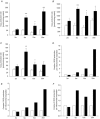Mitochondrial reactive oxygen species production and respiratory complex activity in rats with pressure overload-induced heart failure
- PMID: 24951621
- PMCID: PMC4192702
- DOI: 10.1113/jphysiol.2014.274704
Mitochondrial reactive oxygen species production and respiratory complex activity in rats with pressure overload-induced heart failure
Abstract
We investigated the impact of cardiac reactive oxygen species (ROS) during the development of pressure overload-induced heart failure. We used our previously described rat model where transverse aortic constriction (TAC) induces compensated hypertrophy after 2 weeks, heart failure with preserved ejection fraction at 6 and 10 weeks, and heart failure with systolic dysfunction after 20 weeks. We measured mitochondrial ROS production rates, ROS damage and assessed the therapeutic potential of in vivo antioxidant therapies. In compensated hypertrophy (2 weeks of TAC) ROS production rates were normal at both mitochondrial ROS production sites (complexes I and III). Complex I ROS production rates increased with the appearance of diastolic dysfunction (6 weeks of TAC) and remained high thereafter. Surprisingly, maximal ROS production at complex III peaked at 6 weeks of pressure overload. Mitochondrial respiratory capacity (state 3 respiration) was elevated 2 and 6 weeks after TAC, decreased after this point and was significantly impaired at 20 weeks, when contractile function was also impaired and ROS damage was found with increased hydroxynonenal. Treatment with the ROS scavenger α-phenyl-N-tert-butyl nitrone or the uncoupling agent dinitrophenol significantly reduced ROS production rates at 6 weeks. Despite the decline in ROS production capacity, no differences in contractile function between treated and untreated animals were observed. Increased ROS production occurs early in the development of heart failure with a peak at the onset of diastolic dysfunction. However, ROS production may not be related to the onset of contractile dysfunction.
© 2014 The Authors. The Journal of Physiology © 2014 The Physiological Society.
Figures






Similar articles
-
Isoflurane differentially modulates mitochondrial reactive oxygen species production via forward versus reverse electron transport flow: implications for preconditioning.Anesthesiology. 2011 Sep;115(3):531-40. doi: 10.1097/ALN.0b013e31822a2316. Anesthesiology. 2011. PMID: 21862887 Free PMC article.
-
Decreased rates of substrate oxidation ex vivo predict the onset of heart failure and contractile dysfunction in rats with pressure overload.Cardiovasc Res. 2010 Jun 1;86(3):461-70. doi: 10.1093/cvr/cvp414. Epub 2009 Dec 24. Cardiovasc Res. 2010. PMID: 20035032
-
Differential effects of the mitochondrial uncoupling agent, 2,4-dinitrophenol, or the nitroxide antioxidant, Tempol, on synaptic or nonsynaptic mitochondria after spinal cord injury.J Neurosci Res. 2009 Jan;87(1):130-140. doi: 10.1002/jnr.21814. J Neurosci Res. 2009. PMID: 18709657 Free PMC article.
-
Oxidative stress and heart failure.Am J Physiol Heart Circ Physiol. 2011 Dec;301(6):H2181-90. doi: 10.1152/ajpheart.00554.2011. Epub 2011 Sep 23. Am J Physiol Heart Circ Physiol. 2011. PMID: 21949114 Review.
-
Mitochondrial oxidative metabolism and uncoupling proteins in the failing heart.Heart Fail Rev. 2015 Mar;20(2):227-49. doi: 10.1007/s10741-014-9457-4. Heart Fail Rev. 2015. PMID: 25192828 Review.
Cited by
-
Ca2+/Calmodulin-Dependent Protein Kinase II Regulation by Inhibitor of RIPK3 Protects against Cardiac Hypertrophy.Oxid Med Cell Longev. 2022 Jul 28;2022:7941374. doi: 10.1155/2022/7941374. eCollection 2022. Oxid Med Cell Longev. 2022. PMID: 36046685 Free PMC article.
-
Loss of dihydrolipoyl succinyltransferase (DLST) leads to reduced resting heart rate in the zebrafish.Basic Res Cardiol. 2015 Mar;110(2):14. doi: 10.1007/s00395-015-0468-7. Epub 2015 Feb 20. Basic Res Cardiol. 2015. PMID: 25697682 Free PMC article.
-
Targeting Mitochondrial Metabolism to Save the Failing Heart.Life (Basel). 2023 Apr 16;13(4):1027. doi: 10.3390/life13041027. Life (Basel). 2023. PMID: 37109556 Free PMC article. Review.
-
Monoamine Oxidases as Potential Contributors to Oxidative Stress in Diabetes: Time for a Study in Patients Undergoing Heart Surgery.Biomed Res Int. 2015;2015:515437. doi: 10.1155/2015/515437. Epub 2015 May 25. Biomed Res Int. 2015. PMID: 26101773 Free PMC article. Review.
-
Small-Molecule Chemical Knockdown of MuRF1 in Melanoma Bearing Mice Attenuates Tumor Cachexia Associated Myopathy.Cells. 2020 Oct 11;9(10):2272. doi: 10.3390/cells9102272. Cells. 2020. PMID: 33050629 Free PMC article.
References
-
- Acker T, Fandrey J, Acker H. The good, the bad and the ugly in oxygen-sensing: ROS, cytochromes and prolyl-hydroxylases. Cardiovasc Res. 2006;71:195–207. - PubMed
-
- Balaban RS, Nemoto S, Finkel T. Mitochondria, oxidants, and aging. Cell. 2005;120:483–495. - PubMed
-
- Barja G. The quantitative measurement of H2O2 generation in isolated mitochondria. J Bioenerg Biomembr. 2002;34:227–233. - PubMed
-
- Baudet S, Kuznetsov A, Merciai N, Gorza L, Ventura-Clapier R. Biochemical, mechanical and energetic characterization of right ventricular hypertrophy in the ferret heart. J Mol Cell Cardiol. 1994;26:1573–1586. - PubMed
-
- Berlett BS, Stadtman ER. Protein oxidation in aging, disease, and oxidative stress. J Biol Chem. 1997;272:20313–20316. - PubMed
Publication types
MeSH terms
Substances
LinkOut - more resources
Full Text Sources
Other Literature Sources
Medical

